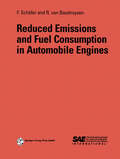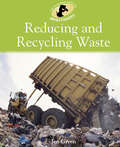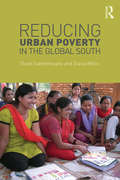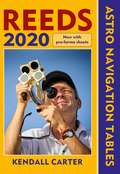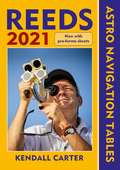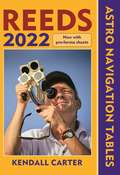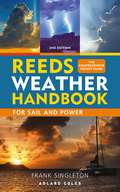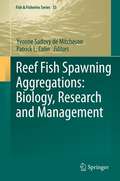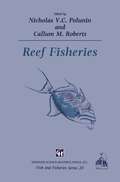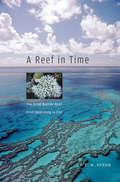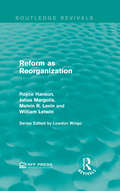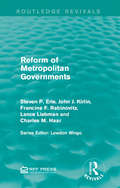- Table View
- List View
Reduced Emissions and Fuel Consumption in Automobile Engines
by Fred Schäfer Richard van BasshuysenOver the last several years, there has been much discussion on the interrelation of CO2 emissions with the global warming phenomenon. This in turn has increased pressure to develop and produce more fuel efficient engines and vehicles. This is the central topic of this book. It covers the underlying processes which cause pollutant emissions and the possibilities of reducing them, as well as the fuel consumption of gasoline and diesel engines, including direct injection diesel engines. As well as the engine-related causes of pollution, which is found in the raw exhaust, there is also a description of systems and methods for exhaust post treatment. The significant influence of fuels and lubricants (both conventional and alternative fuels) on emission behavior is also covered. In addition to the conventional gasoline and diesel engines, lean-burn and direct injection gasoline engines and two-stroke gasoline and diesel engines are included. The potential for reducing fuel consumption and pollution is described as well as the related reduction of CO2 emissions. Finally, a detailed summary of the most important laws and regulations pertaining to pollutant emissions and consumption limits is presented. This book is intended for practising engineers involved in research and applied sciences as well as for interested engineering students.
Reducing and Recycling Waste: Reducing And Recycling Waste (libr (Environment Detective Investigates #4)
by Jen GreenWhat exactly is waste?Why is waste a problem?How can we reduce, reuse and recycle waste?The Environment Detective Investigates helps you to answer these questions and many more about waste. Find out what happens to waste, who produces it and how it causes pollution.
Reducing Climate Impacts in the Transportation Sector
by Daniel Sperling James S. CannonMore than 250 experts from around the world gathered at the Asilomar Transportation and Energy Conference in August 2007 to tackle what many agree is the greatest environmental challenge the world faces: climate change. This 11th Biennial Conference, organized under the auspices of the Energy and Alternative Fuels Committees of the U.S. Transportation Research Board, examined key climate change policy issues and strategies to combat climate impacts from the transportation sector, a leading source of greenhouse gas emissions. This book includes chapters by leading presenters at the Asilomar Conference that reflect the most current views of the world’s experts about a critical and rapidly evolving energy and environmental problem. The chapters in this book examine increasing worldwide emissions of greenhouse gases, uncertain oil supply, evolving climate change science, public attitudes toward climate change, and the implications for the U.S. of growth in China, India and elsewhere. They propose methods to reduce growth in vehicle travel through alternative fuel, new technologies, and land use planning. They examine the costs and the potential for greenhouse gas reduction through deployment of advanced technology and alternative fuels and propose strategies to motivate consumers to buy fuel efficient and alternative fuel vehicles, including heavy duty trucks.
Reducing Greenhouse Gas Emissions and Improving Air Quality: Two Interrelated Global Challenges
by Larry E. Erickson Gary BraseThe world’s atmosphere is a common resource. Air quality, along with energy, transportation, and climate change have significant impacts on our lives and this book helps readers understand the changes happening at the nexus of these areas, as they relate to reducing greenhouse gas emissions and improving air quality. Discussing the transitions to electric vehicles, solar and wind energy for electricity generation, battery developments, smart grids and electric power management, and progress in the electrification of agricultural technology, it also provides the latest information in the context of the United Nations sustainable development goals and the Paris Agreement on Climate Change. Features: Includes content on how to improve urban air quality in large cities and urban environments. Effectively addresses the nexus of energy, transportation, air quality, climate change and health. Discusses innovative concepts at the nexus of renewable energy, smart grid, electric vehicles, and electric power management. Describes recent progress in meeting the goals of the Paris Agreement on Climate Change and the benefits of reducing greenhouse gas emissions. Written for a wide audience by world experts in sustainability. Reducing Greenhouse Gas Emission and Improving Air Quality: Two Interrelated Global Challenges, is an invaluable book for professionals and academics at the center of changes relating to solar and wind energy, electric vehicles, and charging infrastructure, including government officials, community leaders, researchers, students, and interested citizens. It is also an excellent text for classes that address sustainability, particularly for those focused on transportation and energy.
Reducing Greenhouse Gas Emissions and Improving Air Quality: Two Interrelated Global Challenges
by Larry E. Erickson Gary BraseThe world’s atmosphere is a common resource. Air quality, along with energy, transportation, and climate change have significant impacts on our lives and this book helps readers understand the changes happening at the nexus of these areas, as they relate to reducing greenhouse gas emissions and improving air quality. Discussing the transitions to electric vehicles, solar and wind energy for electricity generation, battery developments, smart grids and electric power management, and progress in the electrification of agricultural technology, it also provides the latest information in the context of the United Nations sustainable development goals and the Paris Agreement on Climate Change. Features: Includes content on how to improve urban air quality in large cities and urban environments. Effectively addresses the nexus of energy, transportation, air quality, climate change and health. Discusses innovative concepts at the nexus of renewable energy, smart grid, electric vehicles, and electric power management. Describes recent progress in meeting the goals of the Paris Agreement on Climate Change and the benefits of reducing greenhouse gas emissions. Written for a wide audience by world experts in sustainability. Reducing Greenhouse Gas Emission and Improving Air Quality: Two Interrelated Global Challenges, is an invaluable book for professionals and academics at the center of changes relating to solar and wind energy, electric vehicles, and charging infrastructure, including government officials, community leaders, researchers, students, and interested citizens. It is also an excellent text for classes that address sustainability, particularly for those focused on transportation and energy.
Reducing Urban Poverty in the Global South
by David Satterthwaite Diana MitlinUrban areas in the Global South now house most of the world’s urban population and are projected to house almost all its increase between now and 2030. There is a growing recognition that the scale of urban poverty has been overlooked – and that it is increasing both in numbers and in the proportion of the world’s poor population that live and work in urban areas. This is the first book to review the effectiveness of different approaches to reducing urban poverty in the Global South. It describes and discusses the different ways in which national and local governments, international agencies and civil society organizations are seeking to reduce urban poverty. Different approaches are explored, for instance; market approaches, welfare, rights-based approaches and technical/professional support. The book also considers the roles of clientelism and of social movements. Case studies illustrate different approaches and explore their effectiveness. Reducing Urban Poverty in the Global South also analyses the poverty reduction strategies developed by organized low-income groups especially those living in informal settlements. It explains how they and the federations or networks they have formed have demonstrated new approaches that have challenged adverse political relations and negotiated more effective support. Local and national governments and international agencies can become far more effective at addressing urban poverty at scale by, as is proposed in this book, working with and supporting the urban poor and their organizations. This book will be an invaluable resource for researchers and postgraduate students in urban development, poverty reduction, urban geography, and for practitioners and organisations working in urban development programmes in the Global South.
Reducing Urban Poverty in the Global South
by David Satterthwaite Diana MitlinUrban areas in the Global South now house most of the world’s urban population and are projected to house almost all its increase between now and 2030. There is a growing recognition that the scale of urban poverty has been overlooked – and that it is increasing both in numbers and in the proportion of the world’s poor population that live and work in urban areas. This is the first book to review the effectiveness of different approaches to reducing urban poverty in the Global South. It describes and discusses the different ways in which national and local governments, international agencies and civil society organizations are seeking to reduce urban poverty. Different approaches are explored, for instance; market approaches, welfare, rights-based approaches and technical/professional support. The book also considers the roles of clientelism and of social movements. Case studies illustrate different approaches and explore their effectiveness. Reducing Urban Poverty in the Global South also analyses the poverty reduction strategies developed by organized low-income groups especially those living in informal settlements. It explains how they and the federations or networks they have formed have demonstrated new approaches that have challenged adverse political relations and negotiated more effective support. Local and national governments and international agencies can become far more effective at addressing urban poverty at scale by, as is proposed in this book, working with and supporting the urban poor and their organizations. This book will be an invaluable resource for researchers and postgraduate students in urban development, poverty reduction, urban geography, and for practitioners and organisations working in urban development programmes in the Global South.
Reeds Astro Navigation Tables 2020
by Kendall CarterReeds Astro Navigation Tables is an established book of annual astro-navigation tables compiled specifically for the needs of yachtsmen. It contains all the information the ocean-going sailor needs (without the bulk) in order to navigate by the sun, moon, planets and stars, using tables devised by practical ocean navigators. This book, together with a sextant, will enable sailors to navigate confidently and safely when out of the sight of land.The book continues to feature the well-received additions of the past couple of years, including forms to help determine True Altitude (for the sun, planets and stars), Calculated Altitude (using the versine formula) and Azimuth (using the ABC Tables), as well as a pro forma for calculating Intercept. With 8 extra pages and an improved layout, there is plenty of space for making notes and calculations.
Reeds Astro Navigation Tables 2021
by Kendall CarterReeds Astro Navigation Tables is the established book of annual astro-navigation tables compiled specifically for the needs of yachtsmen. It contains all the information the ocean-going sailor needs (without the bulk) in order to navigate by the sun, moon, stars and planets, using tables devised by practical ocean navigators. This book, together with a sextant, will enable sailors to navigate confidently and safely when out of the sight of land.The book continues to feature the well-received additions of the past few years, including forms to help determine True Altitude (for the sun, stars and planets), Calculated Altitude (using the versine formula) and Azimuth (using the ABC Tables), as well as a pro forma for calculating Intercept. With 8 extra pages and an improved layout, there is plenty of space for making notes and calculations.
Reeds Astro Navigation Tables 2022
by Kendall CarterReeds Astro Navigation Tables is the established book of annual astro-navigation tables compiled specifically for the needs of yachtsmen. It contains all the information the ocean-going sailor needs (without the bulk) in order to navigate by the sun, moon, stars and planets, using tables devised by practical ocean navigators. This book, together with a sextant, will enable sailors to navigate confidently and safely when out of the sight of land. The book continues to feature the well-received additions of the past few years, including forms to help determine True Altitude (for the sun, stars and planets), Calculated Altitude (using the versine formula) and Azimuth (using the ABC Tables), as well as a pro forma for calculating Intercept. With 8 extra pages and an improved layout, there is plenty of space for making notes and calculations.
Reeds Weather Handbook: For Sail And Power
by Frank SingletonWeather determines when we sail, where we sail to – and whether we arrive safely. This essential pocket-sized guide equips the reader with all the necessary tools to predict and deal with local and distant weather conditions, whether on a day trip or a longer cruise, along the coast or further offshore.Each topic is broken down into digestible chapters, explaining the origins and effects of the full spectrum of weather conditions, including:- using and evaluating weather forecasts- depressions, fronts, isobars and other coastal effects- waves and swell- weather lore and sky watching. Meteorology is still advancing and sources of forecasts are changing. This new edition keeps the handbook up-to-date, with a particular focus on the increasing use of GRIB files, computer weather modelling and sources of forecasts, especially with the proliferation of computer forecasts becoming available free of charge.With practical explanations and helpful diagrams and photographs, this is the ideal aide-memoire for skippers and crew, especially those studying for their Day Skipper and Yachtmaster exams.
Reeds Weather Handbook
by Frank SingletonWeather determines when we sail, where we sail to – and whether we arrive safely. This essential pocket-sized guide equips the reader with all the necessary tools to predict and deal with local and distant weather conditions, whether on a day trip or a longer cruise, along the coast or further offshore.Each topic is broken down into digestible chapters, explaining the origins and effects of the full spectrum of weather conditions, including:- using and evaluating weather forecasts- depressions, fronts, isobars and other coastal effects- waves and swell- weather lore and sky watching. Meteorology is still advancing and sources of forecasts are changing. This new edition keeps the handbook up-to-date, with a particular focus on the increasing use of GRIB files, computer weather modelling and sources of forecasts, especially with the proliferation of computer forecasts becoming available free of charge.With practical explanations and helpful diagrams and photographs, this is the ideal aide-memoire for skippers and crew, especially those studying for their Day Skipper and Yachtmaster exams.
Reef Fish Spawning Aggregations: Biology, Research and Management (Fish & Fisheries Series #35)
by Yvonne Sadovy Sadovy de Mitcheson and Patrick L. L. ColinReef fish spawning aggregations, ranging from small groups to many tens of thousands of individuals, are spectacular but poorly known natural phenomena whereby fish assemble at specific times and locations to spawn. For some species these large groups may be the only form of reproduction, the high fish numbers briefly giving a false impression of stability and abundance—an ‘illusion of plenty’. They are often a focus for intensive seasonal fishing because of their predictability and because many important commercial fishes form them. Highly vulnerable to overexploitation, many aggregations and their associated fisheries, have disappeared or are in decline. Few are effectively managed or incorporated into protected areas. Aggregations are not well understood by fishery scientists, managers and conservationists and their significance little appreciated by fishers or the wider public. To ensure their persistence to replenish important fisheries in coral ecosystems, maintain their ecosystem function and continue to delight divers, a significant change in perspective is needed to foster protection and management. This book provides comprehensive and practical coverage of the biology, study and management of reef fish aggregations, exploring their how, when, where, and why. It explores ways to better protect, study, manage and conserve them, while identifying key data gaps and questions. The text is extensively illustrated with many unique, never before published, photographs and graphics. Case studies on over 20 interesting and important fishes are included, outlining their biology and fisheries and highlighting major concerns and challenges.
Reef Fisheries (Fish & Fisheries Series #20)
by Polunin Nicholas V. C. C. RobertsReef ecosystems extend throughout the tropics. Exploited by small-scale fishers, reefs supply food for millions of people, but, worldwide, there are growing worries about the productivity and current state of these ecosystems. Reef fish stocks display many features of fisheries elsewhere. However, habitat spatial complexity, biological diversity within and among species, ecosystem intricacy and variable means of exploitation make it hard to predict sustainable modes and levels of fishing.
A Reef in Time: The Great Barrier Reef from Beginning to End
by J.E.N. VeronLike many coral specialists fifteen years ago, J.E.N. Veron thought Australia’s Great Barrier Reef was impervious to climate change. “Owned by a prosperous country and accorded the protection it deserves, it would surely not go the way of the Amazon rain forest or the parklands of Africa, but would endure forever. That is what I thought once, but I think it no longer.” This book is Veron’s Silent Spring for the world’s coral reefs. Veron presents the geological history of the reef, the biology of coral reef ecosystems, and a primer on what we know about climate change. He concludes that the Great Barrier Reef and, indeed, most coral reefs will be dead from mass bleaching and irreversible acidification within the coming century unless greenhouse gas emissions are curbed. If we don’t have the political will to confront the plight of the world’s reefs, he argues, current processes already in motion will become unstoppable, bringing on a mass extinction the world has not seen for 65 million years. Our species has cracked its own genetic code and sent representatives of its kind to the moon—we can certainly save the world’s reefs if we want to. But to achieve this goal, we must devote scientific expertise and political muscle to the development of green technologies that will dramatically reduce greenhouse emissions and reverse acidification of the oceans.
Reek
by null Alastair ChisholmClimate catastrophe leaves the people of Earth fighting for oxygen in this gripping dystopian thriller from bestselling sci-fi author Alastair Chisholm. Sparrow lives in the world after the Reek. The atmosphere is toxically polluted, and Axel Brodie, the tech billionaire behind Zephyr Industries, is cashing in as the only supplier of clean air. Sparrow is struggling to help her family survive until her brilliant inventor friend, Miriam Fenn, comes up with a new form of technology that could break Zephyr’s stranglehold on the air supply. But men like Brodie are hard to defeat, and he will do everything in his power to stop Miriam and Sparrow. Who will triumph in this battle to breathe?
Reflections: Understanding Our Use and Abuse of Water
by Mark ZeitounWater is central to all life, but we use it to destroy. Water can nourish, but we use it to starve. It can cleanse and unify, but we ensure it contaminates and divides. The consequences of continuing to desecrate or beginning to restore water's inner grace are tremendousand will reflect as much on us as portend our future. Drawing upon twenty-five years of professional work as a water engineer, negotiator, and scholar, Mark Zeitoun provides a unique insider's account of this phenomenon. He explains how unchecked assumptions about water mix with political and economic systems to create an insatiable and ruinous thirst for ever more water. He shows how we use water to lethal effect in wars, and demolish drinking-water systems with wanton disregard. He questions why we transform the most majestic of rivers into canals which spark international conflict and challenge our capacity for preventative diplomacy. The answers reflect more about our society than we might care to admit. If we are to restore water's inner grace, Zeitoun argues, we should worry not so much about "saving" water, but think about what we do with it when it is in our hands.
Reflections: Understanding Our Use and Abuse of Water
by Mark ZeitounWater is central to all life, but we use it to destroy. Water can nourish, but we use it to starve. It can cleanse and unify, but we ensure it contaminates and divides. The consequences of continuing to desecrate or beginning to restore water's inner grace are tremendousand will reflect as much on us as portend our future. Drawing upon twenty-five years of professional work as a water engineer, negotiator, and scholar, Mark Zeitoun provides a unique insider's account of this phenomenon. He explains how unchecked assumptions about water mix with political and economic systems to create an insatiable and ruinous thirst for ever more water. He shows how we use water to lethal effect in wars, and demolish drinking-water systems with wanton disregard. He questions why we transform the most majestic of rivers into canals which spark international conflict and challenge our capacity for preventative diplomacy. The answers reflect more about our society than we might care to admit. If we are to restore water's inner grace, Zeitoun argues, we should worry not so much about "saving" water, but think about what we do with it when it is in our hands.
Reforesting Landscapes: Linking Pattern and Process (Landscape Series #10)
by Harini Nagendra Jane SouthworthThe 21st century has seen the beginnings of a great restoration effort towards the world’s forests, accompanied by the emergence of an increasing literature on reforestation, regeneration and regrowth of forest cover. Yet to date, there is no volume which synthesises current knowledge on the extent, trends, patterns and drivers of reforestation. This edited volume draws together research from leading researchers to explore reforestation and forest regrowth across the world, from multiple dimensions – including ecosystem services, protected areas, social institutions, economic transitions, remediation of environmental problems, conservation and land abandonment – and at different scales. Detailing the methods and analyses used from across a wide range of disciplines, and incorporating research from North, South and Central America, Africa, Asia and Europe, this groundbreaking book provides a global overview of current trends, explores their underlying causes and proposes future forest trajectories. The first of its kind, the book will provide an invaluable reference for researchers and students involved in interdisciplinary research and working on issues relevant to the biophysical, geographic, socioeconomic and institutional processes associated with reforestation.
Reform as Reorganization (Routledge Revivals)
by Royce Hanson Julius Margolis Melvin R. Levin William LetwinAs the fourth report in a series on the Governance of Metropolitan Areas, Reform as Reorganization explores the welfare and development of metropolitan America in terms of political reorganization. Originally published in 1974, this study reflects on metropolitan problems and governmental structure to provide some new options for policy makers and an overview of what political action can be taken. This title will be of interest to students of Environmental Studies as well as professionals.
Reform as Reorganization (Routledge Revivals)
by Royce Hanson Julius Margolis Melvin R. Levin William LetwinAs the fourth report in a series on the Governance of Metropolitan Areas, Reform as Reorganization explores the welfare and development of metropolitan America in terms of political reorganization. Originally published in 1974, this study reflects on metropolitan problems and governmental structure to provide some new options for policy makers and an overview of what political action can be taken. This title will be of interest to students of Environmental Studies as well as professionals.
Reform in CEE-Countries with Regard to European Enlargement: Institution Building and Public Administration Reform in the Environmental Sector (Environmental Protection in the European Union #1)
by LotharKnopp MichaelSchmidtIn May 2004, a series of countries, most of them in Central and Eastern Europe, will become new member states of the EU. The institutional reforms necessary to cope with this enlargement of the EU are prescribed by The Treaty of Nice of 26 February 2001. This volume contains the papers discussed at a conference held at Brandenburg University of Technology, on the guidelines, instruments and programmes available to facilitate the accession of CEE countries to the EU, taking Poland as an example. The main topics of the conference were EC law, particularly EC administrative and environmental law and their incorporation into national law, organizational and administrative mechanisms necessary to carry out this process, as well as the latest EU development programmes for CEE accession countries.
Reform of Metropolitan Governments (Routledge Revivals)
by Steven P. Erie John J. Kirlin Francine F. Rabinovitz Lance Liebman Charles M. HaarOriginally published in 1972, this study aims to explore governmental interaction with people and publics interests and institutions in Metropolitan America. These papers discuss issues of how governance can be improved and the federal role in Metropolitanism as well as suggesting ways in which political reform can help. This title will be of interest to students of Environmental Economics and professionals.
Reform of Metropolitan Governments (Routledge Revivals)
by Steven P. Erie John J. Kirlin Francine F. Rabinovitz Lance Liebman Charles M. HaarOriginally published in 1972, this study aims to explore governmental interaction with people and publics interests and institutions in Metropolitan America. These papers discuss issues of how governance can be improved and the federal role in Metropolitanism as well as suggesting ways in which political reform can help. This title will be of interest to students of Environmental Economics and professionals.
Reforming New Zealand Secondary Education: The Picot Report and the Road to Radical Reform (Secondary Education in a Changing World)
by R. OpenshawThis timely book argues that the New Zealand educational reforms were the product of longstanding unresolved educational issues that came to a head during the profound economic and cultural crisis of the 1970s and early 1980s.
